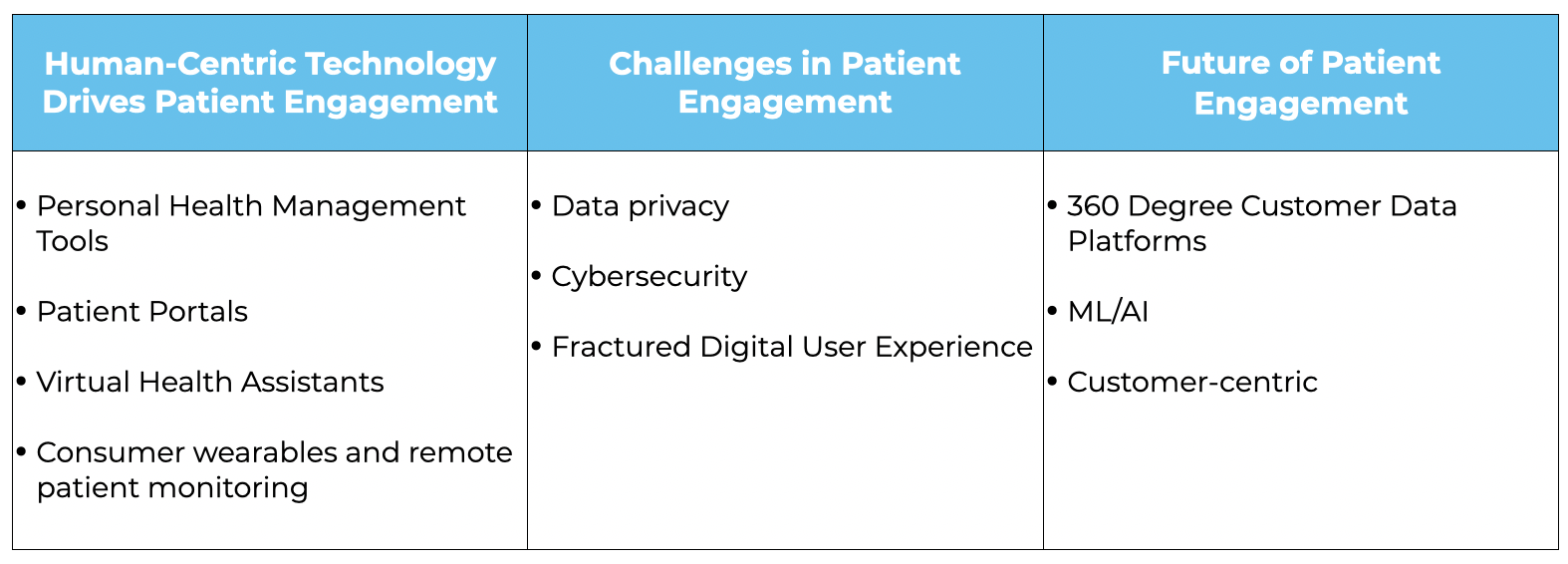The COVID-19 pandemic forced many patients to take their healthcare journey online and pushed providers to seek new ways to engage, diagnose and treat patients. By embracing digital technology, patients and providers have been able to connect and communicate with each other outside of traditional hospital walls―proving that HealthTech holds the key to a more efficient, post-pandemic healthcare system.
Technology Improves Patient Engagement
Digital technology in healthcare is all about communication and collaboration―communication between patients and providers, between healthcare professionals, between devices, and between departments and medical facilities. When patients feel listened to and communicated with instead, they become more engaged in their own healthcare. An engaged and activated patient is more likely to follow their prescribed treatment plan leading to better health outcomes for patients, lower overall costs for payors, and improved capacity utilization for providers.

We accelerate your time-to-market:
Read Full Article
Human-Centric Technology Drive Patient Engagement
By facilitating guidance and support throughout the continuum of care, technology can play an important role in enhancing patient engagement and activation.- Personal Health Management Tools enable patients to track symptoms and collect data on their own health conditions and lifestyle habits. These tools enable patients to share their data with their healthcare providers, allowing for personalized care and lower health care costs.
- Patient Portals improve patients' ability to contact their healthcare providers through secure messaging systems, access their health data, schedule appointments, and pay bills online. Providers benefit from patient portals because they boost efficiency and automate time-consuming manual processes.
- Virtual Health Assistants are being utilized for digital patient triage, to respond to patients’ questions in real-time, and help engage, inform and empower them within the comfort of their own homes.
- Consumer wearables and remote patient monitoring offer an engaging user experience, at an affordable price point, to enhance self-care and compliance with doctor-prescribed regimens. They also provide additional sources of pervasive longitudinal data to healthcare providers.
Challenges In Patient Engagement
Although a successful patient engagement strategy yields numerous benefits, it also brings new technology challenges and threats.- Data privacy
Creating a seamless experience using data requires a secure and robust data infrastructure that follows patients throughout their healthcare journey, and enables healthcare stakeholders to access patient data quickly and securely.
- Cybersecurity
Health data leaks are among the top personal data leaks around the world. This can negatively affect patient engagement, as people are more likely to withhold medical information when they are concerned about their health care provider’s cybersecurity practices. - Fractured Digital User Experience
Historically, the patient user experience has been fragmented and inefficient. The challenge with developing and maintaining digital front doors is that they need to be integratable with existing systems to provide customers with an intuitive experience.
The Way Ahead
Further advancements in the development and use of digital products and services will have a great impact on the healthcare industry and the patient engagement evolution.- 360 Degree Customer Data Platforms
As care delivery organizations seek to get a 360-degree longitudinal view of patients, it’s imperative that they break down patient-related data silos that exist today in their CRM, EHR, HIS systems, and aggregate them along with wearables data, RPM data, and patient-reported outcomes.
- ML/AI
With access to a great variety of data, algorithms will get smarter and process complex patterns in smarter ways over time. AI will be used to make human doctors more efficient, and create user experiences that drive next-level engagement and fuel the digital transformation.
- Customer-centric
In a growing market with shifting consumer expectations and increased competition from tech giants, healthcare companies will need to make the shift from a fee-for-service model to value-based care (VBC) models which require more committed levels of patient engagement if they want to succeed.
Why Patient Engagement Is Key to Success
As consumers’ demand for convenience, personalization, and high-touch service drive how they access, receive, and pay for care, engaging and activating patients is becoming imperative for the healthcare industry. By recognizing the consumer as the central focus of value-based healthcare, along with the widespread adoption of data-driven solutions and advanced technologies in the healthcare ecosystem, patients will become more engaged and compliant to follow their prescribed treatment plan which ultimately leads to better health outcomes for patients, lower overall costs for payors, and improved capacity utilization for providers.
Like What You Read?
Our full article about how digital technology can empower patients, increase patient engagement, and improve overall health outcomes can be downloaded for free.
About Encora
We are an industry-leading product engineering services firm that helps technology companies build best-in-class digital products and platforms via dedicated nearshore and offshore teams using a combination of industrial-grade agile software engineering, consumer-grade experiences, and data-driven insights.
For disruptive healthtech companies, Encora can accelerate your time-to-market and adoption by bringing to bear our experience working with leaders in Telehealth & Virtual Care, Remote Patient Monitoring & Connected Care, Patient Engagement, Hospital Administration, and EHR & Revenue Cycle Management.
